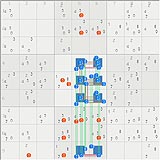- Code: Select all
002009060040001000006030400000020000009700003003000105000000680300507000400100000
18 3 2 | 4 57 9 | 57 6 18
5789 4 -578 | 6 57 1 | 23579 23579 289
1579 1579 6 | 28 3 28 | 4 1579 19
--------------------+-------------------+------------------
1578 1578 4 | 389 2 358 | 789 79 6
2568 258 9 | 7 1 4568 | 28 24 3
2678 278 3 | 89 4689 468 | 1 2479 5
--------------------+-------------------+------------------
2579 2579 157 | 239 49 234 | 6 8 -12479
3 -2689 A18 | 5 4689 7 |B29 B129 -1249
4 -26789 A78 | 1 689 268 | 35 35 B279
Sets: A = {r8c3,r9c3} = {178}
B = {r8c7,r8c8,r9c9} = {1279}
x,z = 1,7 or x,z = 7,1
Exclusions: digit 1 from row 8 ( r8c9<>1 )
digit 7 from row 9 ( r9c2<>7 )
digit 8 from box 7 ( r89c2<>8 )
digit 8 from col 3 ( r2c3<>8 ) [edit: added per Myth Jellies]
digits 2 and 9 from box 9 ( r78c9<>2, r78c9<>9 )
Solvers using almost-locked-sets (ALS) will find the sets noted above and also find the interchangeability of x and z. But this will likely only cause eliminations r8c9<>1 and r9c2<>7.
But the very reason x and z are interchangeable means sets A and B are doubly linked. Using bennys' terminology, both x and z are "restricted common". This means both sets become "locked" and "disjoint" from the rest of the puzzle ... allowing additional exclusions.
This scenario may also be viewed as a continuous nice loop of two almost-locked sets:
-7-(ALS:r9c3=7|1=r8c3)-1-(ALS:r8c78=1|7=r9c9)-
[edit: added starting grid]


